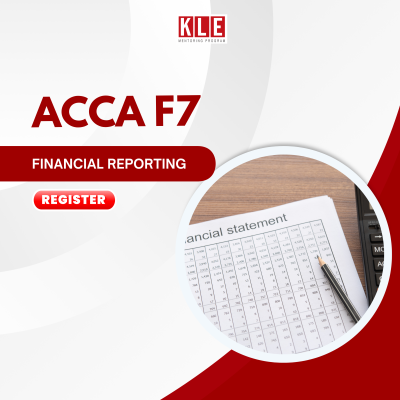Tᚥi KLE Mentoring Program, các mentees sáš― ÄÆ°áŧĢc Äào tᚥo váŧ Thái Äáŧ – Káŧđ nÄng – Kiášŋn tháŧĐc Äáŧ tráŧ thành kiáŧm toán viên phù háŧĢp. Khóa háŧc F7 ACCA hÆ°áŧng Äášŋn trang báŧ cho mentee váŧ phᚧn kiášŋn tháŧĐc chuyên môn – máŧt yêu cᚧu cÄn bášĢn Äáŧi váŧi ngÆ°áŧi hành ngháŧ kiáŧm toán.âŊ
Sau khi hoàn thành khóa FR/F7 ACCA, mentees có tháŧ áŧĐng dáŧĨng kiášŋn tháŧĐc Äáŧ thi môn Financial Reporting Äáŧ tiášŋp táŧĨc cháš·ng ÄÆ°áŧng chinh pháŧĨc cháŧĐng cháŧ ACCA. Äáŧi váŧi các bᚥn sinh viên, kiášŋn tháŧĐc táŧŦ khóa háŧc F7 là hành trang giúp các bᚥn thành công tᚥi các cuáŧc thi chuyên môn Kášŋ toán – Kiáŧm toán và xa hÆĄn là tham gia các Kì tuyáŧn dáŧĨng Tháŧąc tášp sinh Kiáŧm toán tᚥi các công ty kiáŧm toán láŧn.
1. Náŧi dung háŧc
* FR/F7 – Financial Reporting bao gáŧm 5 phᚧn chính:
- The conceptual and regulatory framework: Khung khái niáŧm và khung pháp lý váŧ kášŋ toánâŊ
- Accounting for transactions in financial statements: Hᚥch toán các giao dáŧch trong báo cáo tài chính
- Preparing single entity financial statements: Lášp báo cáo tài chính riêng lášŧ
- Preparing consolidated financial statements: Lášp báo cáo tài chính háŧĢp nhášĨt
- Analysis and interpretation of financial statements: Phân tích và giášĢi thích các báo cáo tài chính
* So váŧi môn háŧc FA/F3, môn háŧc FR/F7 Äáŧ cášp Äášŋn nháŧŊng phᚧn kiášŋn tháŧĐc pháŧĐc tᚥp hÆĄn nhÆ°:
- BášĨt Äáŧng sášĢn Äᚧu tÆ° (IAS 40, Investment Property)
- Tài sášĢn nông nghiáŧp (IAS 41, Agriculture)
- Thuê (IFRS 16, Lease)
- Chi phí váŧn hóa (IAS 23, Borrowing cost)
- Công cáŧĨ tài chính (IFRS 9, Financial instruments)
- Thuášŋ (IAS 12)
- Phân tích cháŧ sáŧ trên báo cáo tài chính
2. MáŧĨc tiêu cáŧ§a môn háŧc FR/F7
MáŧĨc tiêu chung
Trong môn háŧc FR/F7 – Financial Reporting, ngÆ°áŧi háŧc sáš― ÄÆ°áŧĢc:
MáŧĨc tiêu váŧi ngháŧ kiáŧm toán
Äáŧi tÆ°áŧĢng (subject matter) cáŧ§a công viáŧc kiáŧm toán là Báo cáo tài chính, vì vášy kiáŧm toán viên cᚧn ÄÆ°áŧĢc trang báŧ Äᚧy Äáŧ§ kiášŋn tháŧĐc váŧ Kášŋ toán tài chính. Môn FR/F7 – Financial Reporting sáš― cung cášĨp hiáŧu biášŋt váŧ các chuášĐn máŧąc báo cáo tài chính và cách các chuášĐn máŧąc ÄÆ°áŧĢc áp dáŧĨng trong quá trình lášp báo cáo tài chính. Äây là cÆĄ sáŧ Äáŧ kiáŧm toán viên ÄÆ°a ra ý kiášŋn váŧ sáŧą trung tháŧąc và háŧĢp lý cáŧ§a các thông tin trên báo cáo tài chính cáŧ§a ÄÆĄn váŧ.
3. Hình tháŧĐc tham gia thi FR/F7
Bài thi FR/F7 kéo dài 3 tiášŋng và 10 phút cho thí sinh Äáŧc Äáŧ. TášĨt cášĢ các câu háŧi là bášŊt buáŧc. Bài kiáŧm tra sáš― bao gáŧm cášĢ yášŋu táŧ tính toán và giášĢi thích.
Bài thi FR/F7gáŧm 3 phᚧn:
Các câu háŧi cáŧ§a phᚧn 1 và phᚧn 2 có tháŧ bao gáŧm tášĨt cášĢ các kiášŋn tháŧĐc cáŧ§a Kášŋ toán tài chính ( Bao gáŧm cášĢ FA/F3 và FR/F7). Phᚧn 3 sáš― kiáŧm tra viáŧc giášĢi thích và lášp báo cáo tài chính cho máŧt ÄÆĄn váŧ.
5 Bà i háŧc - 0 phÚt
3 Bà i háŧc - 23 phÚt
10 Bà i háŧc - 1 giáŧ 54 phÚt
4 Bà i háŧc - 27 phÚt
17 Bà i háŧc - 2 giáŧ 37 phÚt
11 Bà i háŧc - 1 giáŧ 20 phÚt
9 Bà i háŧc - 51 phÚt
9 Bà i háŧc - 1 giáŧ 9 phÚt
12 Bà i háŧc - 1 giáŧ 12 phÚt
1 Bà i háŧc - 0 phÚt
12 Bà i háŧc - 2 giáŧ 10 phÚt
10 Bà i háŧc - 2 giáŧ 15 phÚt
6 Bà i háŧc - 31 phÚt
18 Bà i háŧc - 2 giáŧ 58 phÚt
10 Bà i háŧc - 1 giáŧ 43 phÚt
13 Bà i háŧc - 1 giáŧ 44 phÚt
8 Bà i háŧc - 1 giáŧ 14 phÚt
11 Bà i háŧc - 2 giáŧ 57 phÚt
1 Bà i háŧc - 0 phÚt
1 Bà i háŧc - 0 phÚt
11 Bà i háŧc - 2 giáŧ 52 phÚt
10 Bà i háŧc - 2 giáŧ 32 phÚt
6 Bà i háŧc - 1 giáŧ 19 phÚt
14 Bà i háŧc - 3 giáŧ 17 phÚt
9 Bà i háŧc - 3 giáŧ 4 phÚt
7 BÃ i háŧc - 2 giáŧ
3 Bà i háŧc - 1 giáŧ 38 phÚt
10 Bà i háŧc - 4 giáŧ 8 phÚt
5 Bà i háŧc - 1 giáŧ 29 phÚt
3 Bà i háŧc - 1 giáŧ 58 phÚt
Cháŧ Phᚥm Háŧ Äiáŧp
Former Manager, KPMG Vietnam
Complete ACCA Program
